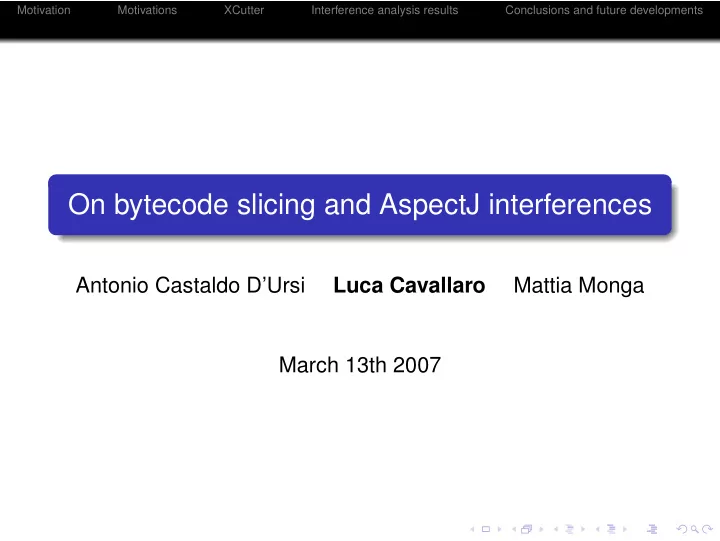

Motivation Motivations XCutter Interference analysis results Conclusions and future developments On bytecode slicing and AspectJ interferences Antonio Castaldo D’Ursi Luca Cavallaro Mattia Monga March 13th 2007
Motivation Motivations XCutter Interference analysis results Conclusions and future developments Outline Motivations 1 XCutter 2 Interference analysis results 3 Conclusions and future developments 4
Motivation Motivations XCutter Interference analysis results Conclusions and future developments Outline Motivations 1 XCutter 2 Interference analysis results 3 Conclusions and future developments 4
Motivation Motivations XCutter Interference analysis results Conclusions and future developments Aspects and modularization Aspects describe crosscutting computations, referring to an abstract view of the system Composition is performed by the weaving process Code affected by an aspect is oblivious about that (it does not contain any clue about if an aspect might be advised on it) As a result while aspect code units are physically separated they might unwittingly be not logically distinct
Motivation Motivations XCutter Interference analysis results Conclusions and future developments Aspect interference We defined a notion of aspect interference To quantify aspect interference we focused on the portion of a program affected by an aspect Our definition is based on the observation of the system state Definition An aspect A does not interfere with a code unit C if and only if every interesting predicate on the state manipulated by C is not changed by the application of A .
Motivation Motivations XCutter Interference analysis results Conclusions and future developments Interference for AspectJ programs We derived an operative test for AspectJ programs Our test is based on backward static slicing Given a criterion the backward static slice is the set of instructions in the source code that influence the criterion Definition A 1 and A 2 are two aspects S 1 and S 2 the corresponding backward slices obtained by using all the statements defined in A 1 and A 2 as slicing criteria A 1 does not interfere with A 2 if A 1 ∩ S 2 = ∅ .
Motivation Motivations XCutter Interference analysis results Conclusions and future developments Outline Motivations 1 XCutter 2 Interference analysis results 3 Conclusions and future developments 4
Motivation Motivations XCutter Interference analysis results Conclusions and future developments A bytecode level slicer featuring AspectJ constructs To verify our operative condition we built XCutter It is a bytecode level slicer that can analyze both Java and AspectJ programs Main features Based on Soot a Uses an IR to do analysis Features our space efficient slicing algorithm More details in our master thesis b a http://www.sable.mcgill.ca/soot/ b http://www.elet.polimi.it/upload/cavallaro/thesis/thesis.pdf
Motivation Motivations XCutter Interference analysis results Conclusions and future developments Outline Motivations 1 XCutter 2 Interference analysis results 3 Conclusions and future developments 4
Motivation Motivations XCutter Interference analysis results Conclusions and future developments What we expected vs what we found Expected result Given two pieces of advice A 1 and A 2 If A 1 reads a variable x and A 2 writes the same x A 1 does not interfere with A 2 Obtained result We have interference also in this case
Motivation Motivations XCutter Interference analysis results Conclusions and future developments The after finally advice The tool detects spurious interferences in presence of after finally pieces of advice The translation introduces control dependencies between aspect bytecode instructions These dependencies may not be interesting for the programmer
Motivation Motivations XCutter Interference analysis results Conclusions and future developments The after finally advice
Motivation Motivations XCutter Interference analysis results Conclusions and future developments Outline Motivations 1 XCutter 2 Interference analysis results 3 Conclusions and future developments 4
Motivation Motivations XCutter Interference analysis results Conclusions and future developments What we can do Using annotations, the tool could ignore these dependencies Deciding if ignoring weaving introduced dependencies is safe is not trivial In our examples they were not significative A formal analysis of the problem is needed
Motivation Motivations XCutter Interference analysis results Conclusions and future developments Future work A deeper study on correctness of ignoring dependencies is needed The proposed system is easy to implement It can be unsafe Even if unsafe this analysis could discover other useful information
Motivation Motivations XCutter Interference analysis results Conclusions and future developments The End Thanks for your attention
Recommend
More recommend